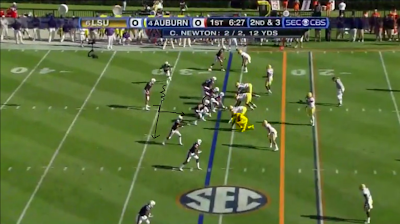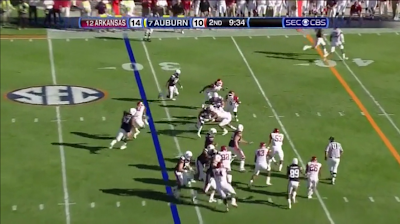This play however is not anything new to the college football landscape. Documented at smart football TCU busted out this play against Clemson last season, and their QB Andy Dalton had a field day. Smart footballs description of the play:
"But TCU ran a variant, one I’ve seen other teams use. They just “inverted” the runningback and quarterback: The runningback runs a sweep or outside zone action laterally. If the defensive end takes him, then the quarterback shoots up inside the defensive end. If the defensive end sits for the QB, the runner should be able to hit the corner. Remember, the defensive end is often the hardest guy to block, and especially so when you want to “reach” him to seal the corner."
For more information on this you can also check out this thread from Coach Huey on the inverted veer (referred to as "Dash") and a few other plays that may be of interest.
It's a pretty simple concept, and meshes well with Auburn's other gap-running schemes perfectly. Once again, of course having Newton really helped this play explode for Auburn, but numerous other teams also employed it with less athletic QB's.
Like the other plays in this offense, Malzahn disguises them well using formations and motions. Along with talking about the different looks Auburn deployed to run the inverted veer, I will also look at some alterations and variations they use.
Here is a diagram showing the basic set up for the inverted veer play.

Much like the rest of their gap run schemes, the front side of the offensive line collapses down on the defensive line, this time leaving the the defensive end unblocked and waiting to be read by the QB.
Here's an example. Auburn aligns in an empty formation with the tailback aligned as the #3 to the left. He will motion into the backfield.

Here's the alignment on the snap of the ball, I've highlighted the DE that Newton will read.

During the mesh between Newton and McCalebb, the tailback, we now clearly see the unblocked defensive end who has made his way up the field. We also see the right offensive tackle releasing to block the sole LB in the box.

The DE clearly commits to taking the sweep being run by McCalebb and Newton correctly reads this and keeps it. However, at this point in time an interior defensive lineman has slipped off his block and will make a shoe string tackle and pursuit from the backside is coming as well. This is what leads me to believe that Malzahn prefers leading with a pulling guard (which I discuss later) to be able to pick up a defender who has defeated a block or backside pursuit.

Inverted Veer "Power"
Auburn will also use a power-like variation by adding a pulling guard to the mix to lead for the QB should he keep the ball. Malzahn seems to prefer this scheme, to the basic inverted veer, I can only assume because the added pulling guard requires no new teaching and gets another body at the POA. Diagram below.

Here is an example of the inverted veer with the added pulling guard element that Malzahn seems to prefer. And as I document more of what Auburn does offensively, their offensive guards are pulling on almost every run play (obviously beside the zone plays).
They start the play in a true empty set, with the tailback aligned in the slot. Much like on the buck sweep Malzahn uses lots of motion into the backfield by the tailback. McCalebbk (TB) will stop before the play starts, so this is not inverted veer off of the jet sweep. I've highlighted the DE who Newton will be reading. Notice the effect that the empty set places on LSU's defensive structure.

On the snap of the ball we see the back side guard pulling and leading and the mesh between Newton and McCalebb the TB. Along with that the pre-snap alignment of the defensive tackle to the play side forces the offensive tackle drive him out. This places the DE in a position that makes Newton's read pretty clear with two defenders outside now, ready to defend the sweep hand off to McCalebb. Finally, we see absolutely no one immediately at the second level for LSU on defense.

Below we clearly see both the defensive tackle and defensive end are now in no position to make a play on Newton's keep, and the pulling guard leading the way to block...well...no one in sight.

And finally Newton with some running room and a lead blocker who is still looking for someone to block.

Inverted Veer "Power" Give
Here is an example of Newton giving to the sweep after making his read. Auburn once again aligns in an empty set with the tailback aligned in the slot to start the play, he will once again motion into the backfield.

During the mesh we see the highlighted DE charging the mesh point. Much like under center veer teams if the hand off key comes down hard the QB is supposed to pull and attack the edge. Since this is the inverted veer and the QB is now the dive portion if the hand off key charges the mesh point then the tailback should now receive the hand off and attack the edge on his sweep path.

After the hand off has been made we now clearly see the highlighted DE was attacking Newton and now that Newton has made the correct read McCalebb now has the ball on the edge.

Finally, we see McCalebb now one on one with a member of the LSU secondary.

Like the other different versions of option football, when executed correctly it is deadly.
Example Two
Here is another example from a different formation against Arkansas.
Auburn aligns in an empty formation once again. This time it's a little different as it is more of a trey look to the left, with the tailback in the slot to the right. McCalebb will motion into the backfield like all the previous examples.

On the snap of the ball we'll see the same thing we've seen on the other versions. I've highlighted the DE, and also tried to show the arc block course that the tight end will take.

During the mesh we see the DE who is the hand off key come down hard on the mesh, so much so he will collision the pulling guard. Along with that we see the great angle that the tight end now has on the linebacker inside.

Newton makes the correct read and hands off to McCalebb who can now continue on his sweep path.

It's unfortunate that McCaleb cuts back into the pursuit and doesn't try to stay outside.

Inverted Veer "Power" Diagrams

Here Auburn aligns in one of their more traditional two-back sets to run the inverted veer "power" play. While the spread sets they love to deploy to run the play, Auburn also does operate out of tighter sets as well.
Hopefully that gives you a good idea of what Auburn has done this year using their inverted veer and inverted veer "power" play. As I come upon more variations I'll post them as well.
Great post Coach! We are definitely going to use this scheme this year. There are so many things you can do in the backfield, while the blocking up front stays the same.
ReplyDeleteQuestion - How do you edit those pictures (adding highlights, etc...)?
Great stuff.
Coach, it's built into the screen capture program I use to make the image. I'm sure you'd be able to do it in almost any photo editing program. I also would assume most computers have some kind of screen capture tool like Snaggit or Snapit.
ReplyDeletegood job on the dash/flash discussion
ReplyDeletefrom tog@coachhuey.com
Great post explaining the inv. Veer!
ReplyDeleteWhat software do you use to draw the plays?
Thanks!
Respect and that i have a nifty proposal: Who Repairs House Foundations typical renovation costs
ReplyDeleteI find it fascinating how this play utilizes misdirection effectively.
ReplyDelete